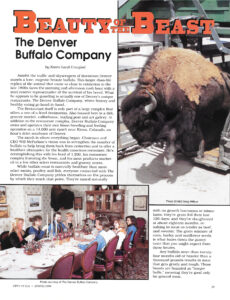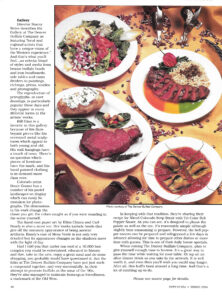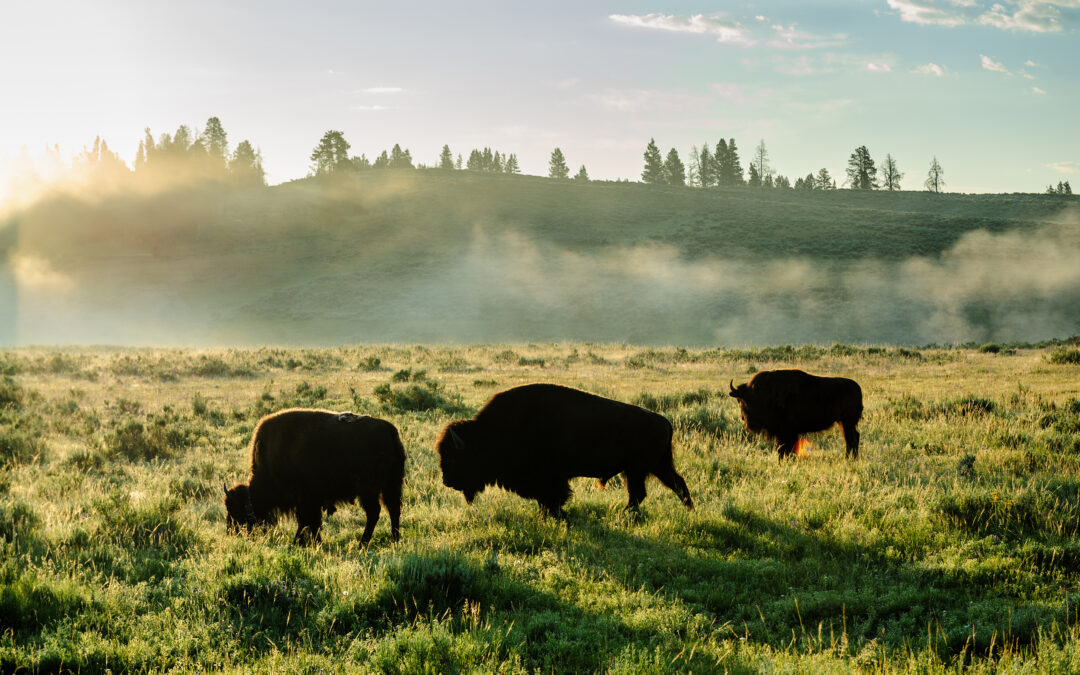Amidst the traffic and skyscrapers of downtown Denver stands a lone, majestic bronze buffalo. This larger-than-life replica of the animal that came so close to extinction in the late 1800’s faces the morning and afternoon rush hour with a steel reserve representative of the survival of his breed. What he appears to be guarding is actually one of Denver’s unique restaurants, The Denver Buffalo Company, where history and healthy eating go hand-in-hand.
 The restaurant itself is only part of a large complex that offers a one-of-a-kind destination. Also housed here is a deli, grocery market, coffeehouse, trading post and art gallery. In addition to the restaurant complex, Denver Buffalo Company owns and operates their own bison breeding and feeding operation on a 14,000 acre ranch near Kiowa, Colorado, an hour’s drive southeast of Denver.
The restaurant itself is only part of a large complex that offers a one-of-a-kind destination. Also housed here is a deli, grocery market, coffeehouse, trading post and art gallery. In addition to the restaurant complex, Denver Buffalo Company owns and operates their own bison breeding and feeding operation on a 14,000 acre ranch near Kiowa, Colorado, an hour’s drive southeast of Denver.
The ranch is where everything began. Chairman and CEO Will McFarlane’s vision was to strengthen the number of buffalo to help bring them back from extinction and to offer a healthier alternative for the health conscious consumer. He’s accomplishing this with his herd of 1,200, his restaurant complex featuring the bison, and his meat products marketed to a few other select restaurants and grocery stores.
While buffalo meat is naturally healthier than most other meats, poultry and fish, everyone connected with The Denver Buffalo Company prides themselves on the process by which they reach that point. They’re raised naturally with no growth hormones or stimulants; they’re grain fed their last 120 days; and they’re slaughtered at about eighteen months, resulting in meat as tender as beef and sweeter. The grain mixture of corn, barley and sunflower seeds is what tones down the gamey taste that you might expect from these brutes.
Any buffalo more than twenty-four months old or heavier than a thousand pounds results in meat that gets gristly and tough. Those beasts are branded as “burger bulls,” meaning they’re good only for ground meat.
Raising buffalo is no easy task. Ranch Manager Doug Stewart says they’re extremely hard to handle because they’re still a wild animal in spite of being fenced in. In fact, there have been times when the high fences, reinforced with highway guardrails, haven’t phased the buffalo in the least. That’s when Stewart and his hands jump on their motorcycles or snowmobiles, depending on the time of year, and head out to round ‘em up.
You pictured more of a cowboy on horseback leading them home? According to Stewart, “They’re way too fast for horses.” But they do use a pickup truck when they work the buffalo in the pens or feedlot. Don’t expect much on trade-in, however. Stewart says “there’s just not a square inch on it that isn’t bashed in.”
Cost is much of the reason that the average-sized buffalo ranch in this country runs less than twenty head. Special fencing, select grains and constant repairs make them much more expensive to raise and maintain than cattle. Couple that with the smaller numbers of buffalo compared to cattle and this, too, affects the market price which is typically higher than beef.
McFarlane is also impacting the international market with an operation in Japan. Its sole purpose is the importing and direct sales of buffalo products. Denver Buffalo Company Public Relations Director Donna Skougor says the Japanese are some of their biggest fans.
“The Japanese really like our products a lot,” she says matter-of-factly. “They love meat but they’re also very, very concerned about cholesterol. It’s a compromise, and I think it tastes better, too.”
Skougor says some people are a little timid about trying buffalo meat, but they can treat it just as they would beef. She says once they try it, it wins them over. And the secret to cooking buffalo meat is using lower heat and not over cooking it She recommends medium rare for both burgers and steaks, otherwise it tends to get a little tough. My own test showed medium rare producing a steak so tender it could almost be cut with a fork. Seasoning buffalo is also similar to beef. In fact, a little cracked pepper, garlic salt and seasoned salt is all it takes.
Unique Dining
 The “Old West” tradition of a welcome smile, a good meal and gracious hospitality is in full swing in the Restaurant. There’s plenty to talk about if you eat in the dual-level main dining room because of the Western memorabilia, period furniture and ornaments. In fact, the entire complex carries that theme with art and artifacts of the Plains Indian. In summer, dining expands to the patio area. And the Great Buffalo Room, with its combination of authentic Western and Victorian décor, is the perfect private dining room for a special group gathering.
The “Old West” tradition of a welcome smile, a good meal and gracious hospitality is in full swing in the Restaurant. There’s plenty to talk about if you eat in the dual-level main dining room because of the Western memorabilia, period furniture and ornaments. In fact, the entire complex carries that theme with art and artifacts of the Plains Indian. In summer, dining expands to the patio area. And the Great Buffalo Room, with its combination of authentic Western and Victorian décor, is the perfect private dining room for a special group gathering.
The menu features a wide array of buffalo dishes including appetizers like Spicy Buffalo Wings or Rocky Mountain Quesadillas filled with shredded buffalo instead of beef. The Buffalo Reuben is a favorite for lunch as is Tatonka (buffalo) Vegetable Soup and Buffaloaf, a meat loaf made with ground buffalo. Dinner entrees include Christmas Chile (green and red buffalo chile divided in the bowl by a flour tortilla) and the popular Buffalo Prime Rib. You’ll also find selections of chicken, seafood and pasta. But don’t look for beef. It’s not available at The Denver Buffalo Company.
Deli & Market
The Deli and Market provides a less formal atmosphere for eating, café style, where they serve up everything from fresh pastries to soups and chilis to deli sandwiches and ice cream. Within the Deli is the Coffee House, a pleasant environment to enjoy a quiet cup of coffee or espresso. A stage area for entertainers makes it perfect for parties.
The refrigerated display cases reveal buffalo in all forms: hickory smoked salami, jerky, fresh and smoked sausages, roast buffalo, corned buffalo, pastrami, steaks, tenderloins, even Buff Dogs (buffalo franks). They’re lower in fat and cholesterol than traditional franks and have an exceptional taste.
If you could possibly be looking for more unique items than those already mentioned, the Market carries Peaberry Coffee and a special blend made just for The Buffalo Company called “Prairie Sunrise.” They also have their own line of products such as Smok ‘N Joe’s Mustard and Smok ‘N Joe’s Barbecue Sauce.
Gift givers with a sense of humor can pick up a can of Cowboy Peanuts, or purchase Canned Buffalo (a canned stuffed animal). And I know the local grocer doesn’t carry Uncle Dougie’s “World’s Most Dangerous Barbecue Sauce” or Unce Dougie’s Torpedo Juice, “The Sure Fire Tomatoe Juice Cocktail.”
Gift Packs are also available. They can be custom designed with your own selections or prepackaged with an assortment of buffalo items. Mail orderif becoming more and more popular and is as easy as dialing their toll free number.
Trading Post
The legend and spirit of the buffalo definitely comes to life through the Trading Post. A grand stuffed bison stands proudly amidst contemporary Western-style clothing, leather goods, home accoutrements, sterling silver jewelry and Native American handcrafts. If it’s the unusual you’re looking for, talk with Trading Post Assistant Director Erica Clark. She says they like to carry items that have stories behind them.
Of particular interest is a fabulous collection of buffalo jewelry seeped in history. Dian Malouf of Dallas is the designer. The buffalo image on her pins and earrings are cut from china that was originally used in the Union Pacific Railway dining cars. They’d been thrown away in a cow pasture near Salt Lake City in the late 1800s. They were then dug up and found forty years later in the closet of an old miner. Malouf bought the broken china at his estate sale and ingeniously turned the leftover pieces into distinctive looking Western jewelry.
One of the clothing lines carried in the Trading Post is Tatonka Weavers. Tatonka is a Lakota Sioux word for buffalo or bison. They specialize in garments, purses and rugs, but a real standout is a vest done by designer Annette Graener. The back of the men’s vest is buffalo hair, beautifully woven and spun with natural dyes. The front is buffalo leather, not as soft as cowhide but just as handsome. Its buttons are, what else? Buffalo head nickels. The women’s vest is the exact opposite of the men’s…buffalo hair on the front with leather lapel and leather back.
Anything you could want in the way of buffalo items can be found in the Trading Post. There are belt buckles, coffee mugs, buffalo head mounts, skulls and beautiful, thick winter hides that make great rugs, wall hangings or breadspreads. If you can stand the weight, try on the full-length buffalo coat. They were worn by stagecoach drivers during the harsh prairie winters. They’re soft and thick, but definitely heavy.
A twenty-foot tall Plains Indian tepee is very impressive as are the Native American artifacts like the headdresses, robes, drums and clothing. And be sure to check out the walking sticks and golf putters. When they say nothing on the animal goes to waste, they mean it!
Gallery
Director Stacey Weiss describes the Gallery at The Denver Buffalo Company as featuring “local and regional artists that have a unique vision of the Western experience.” And that’s what you’ll find…an eclectic blend of styles and media from bronze buffalo heads and iron headboards, side tables and room dividers to paintings, etching, prints, textiles and photography.
The reproduction of petroglyphs, or cave drawings, is particularly popular these days and they appear in many different forms in the artists’ works.
Bill Gian is a favorite in this gallery because of his flamboyant pieces like his oversized metal sculptures which appeal to both young and old. His wall hangings have a touch of neon. There’s no question which pieces of furniture have his mark, and his hand painted clothing is in demand more than ever.
Colorado artist Bruce Gomez has a number of his pastel landscapes on display which can easily be mistaken for photographs. The dimensions to his work change the closer you get: the colors caught as if you were standing in the scene yourself.
The hand cast paper art by Ellen Chiara and Carl Bandy is also a must see. Her works include bowls that give off the uncanny appearance of being ancient artifacts. Bandy’s cast of Mesa Verde is not only very detailed but its appearance changes as the shadows move with the light of day.
Had I told you that under one roof of a 16,000-foot complex you could be entertained, educated in history and diet, take in the arts, enjoy a great meal and do some shopping, you probably would have questioned it. But the folks at The Denver Buffalo Company have put just such a compound together, and very successfully. In their attempt to promote buffalo as the meat of the ‘90s, they’ve also managed to maintain homespun friendliness, a trademark of the Old West.
In keeping with that tradition, they’re sharing their recipe for Sliced Colorado Strip Steak with Tri-Color Bell Pepper Sauce. As you can see, it’s designed to please the palate as well as the eye. It’s reasonably simple although slightly time-consuming to prepare. However, the bell pepper sauces can be prepared and refrigerated a few days in advance allowing for time to prepare other dishes or more time with guests. This is one of their daily house specials.
When visiting the Denver Buffalo Company, plan to give yourself enough time to browse. It’s a great way to pass the time while waiting for your table. Or sip on an after-dinner drink as you take in the artwork. It is well worth it, and even then you’ll wish you could stay longer. After all, this buff’s been around a long time. And that’s a lot of catching up to do.
DENVER BUFFALO COMPANY’S SLICED COLORADO STRIP STEAK WITH TRI-COLOR BELL PEPPER SAUCE
2-8oz Buffalo Strip Steaks
2 medium-sized green bell peppers
2 medium-sized red bell peppers
2 medium-sized yellow bell peppers (follow roasting instructions below)
2 cups of chicken broth
1 medium onion, chopped
3 tablespoons canola or olive oil
1 1/2 teaspoons dried oregano
3/4 teaspoon dried marjoram
3/4 teaspoon ground cumin
salt & pepper to taste
When cooking Buffalo meat, please keep in mind that it has a lower fat content than traditional red meat and must be cooked at slightly lower temperatures. In addition to requiring less cooking time, if cooking on a grill, keep the steaks a little further from the coals. If broiling in the oven, lower your cooking rack another notch down from broiler. We recommend rare to medium rare to maintain tenderness.
After Buffalo Steak Strip has been cooked to desired temperature, slice steak as indicated in the above photo.
When arranging pepper sauce on plate, separate design with a strip of waxed paper as a barrier while pouring. This will divide the colored sauce until it has established a border. Lift the strip of waxed paper after each color has been poured into place.
In the bell pepper family the red pepper tends to be strongest and sweetest in flavor, the yellow is mellower and the green is somewhat tart. This Tri-Color recipe brings three very distinct and compatible flavors to a wonderfully tender and delicately sweet Buffalo Strip Steak.
Roasting Bell Peppers
Roasting bell peppers over an open flame or broiler gives them a delightfully sweet and smoky flavor.
1. Cut bell peppers in half lengthwise; discard seeds and membranes. Place peppers, skin side up, on a foil-lined baking sheet.
2. Broil 3 inches from heat for 10-15 minutes or until skin becomes blackened and blistered.
3. Place peppers in a plastic bag and seal; Let stand 10 to 15 minutes.
4. Peel and discard skin under cold running water.
Roasted Tri-Color Bell Pepper Sauce
The following cooking instructions must be applied to each pepper color group: green, red and yellow. So, this process must be repeated three times. This recipe may be prepared a few days in advance, allowing for minimal preparation of reheating the sauces before serving with grilled or broiled Buffalo Strip Steak.
Chop 2 medium-size roasted peppers (same color). Add 1 tablespoon of canola or olive oil to large saute pan over medium heat. Add 1/3 portion of chopped onion; cover and cook 15 minutes, or until translucent. Add bell papper; cover and cook an additional 5 minutes, stirring occasionally. Sprinkle 1/2 teaspoon dried oregano, 1/4 teaspoon dried marjoram and 1/4 teaspoon ground cumin and stir. Add 1/2 cup of chicken broth and bring to a boil. Remove cover, reduce heat and simmer an additional 20 minutes. Allow stock to condense and mixture to thicken. Add salt and peppe to taste. (Total cooking time – 40 minutes.) Yield: 2 servings.
Remove from heat, and puree ingredients in food processor until smooth and creamy. To thicken the bell pepper puree, return to saute pan and continue to cook down. To thin the bell pepper puree, add more chicken stock.
Denver Buffalo Company’s Buffalo Ravioli
Buffalo Ravioli Filling (yields 36 meatballs for ravioli filling)
1 pound ground Buffalo
2/3 cup minced onion
1/3 cup chopped fresh Italian parsley
1 1/2 tablespoons minced garlic
3 tablespoons freshly grated Reggiano Parmigiano (Parmesan)
1 large fresh egg
1/2 teaspoon course ground black pepper
1/2 teaspoon sea salt
1/2 teaspoon dried oregano
1/2 teaspoon dried thyme
1/3 cup fresh bread crumbs
Mix ingredients together in a large bowl. Roll into individual meatballs-should yield thirty-six 1/2 ounce meatballs.
You may choose to make your own pasta or purchase sheet pasta from your grocer. Won Tons are packaged and sold by the sheet and make a suitable substitute for ravioli. Denver Buffalo Company uses a tri-color dough for this recipe.
Stuff ravioli with meatballs and seal around edges. Preheat deep fryer to 350. Add several ravioli at a time and fry for 4 minutes. Be careful not to overload deep fryer with ravioli-they will stick together. Place fried ravioli on paper towels. When complete-top with your favorite marinara sauce.
# # #
Sad to say, the Denver Buffalo Restaurant closed.

